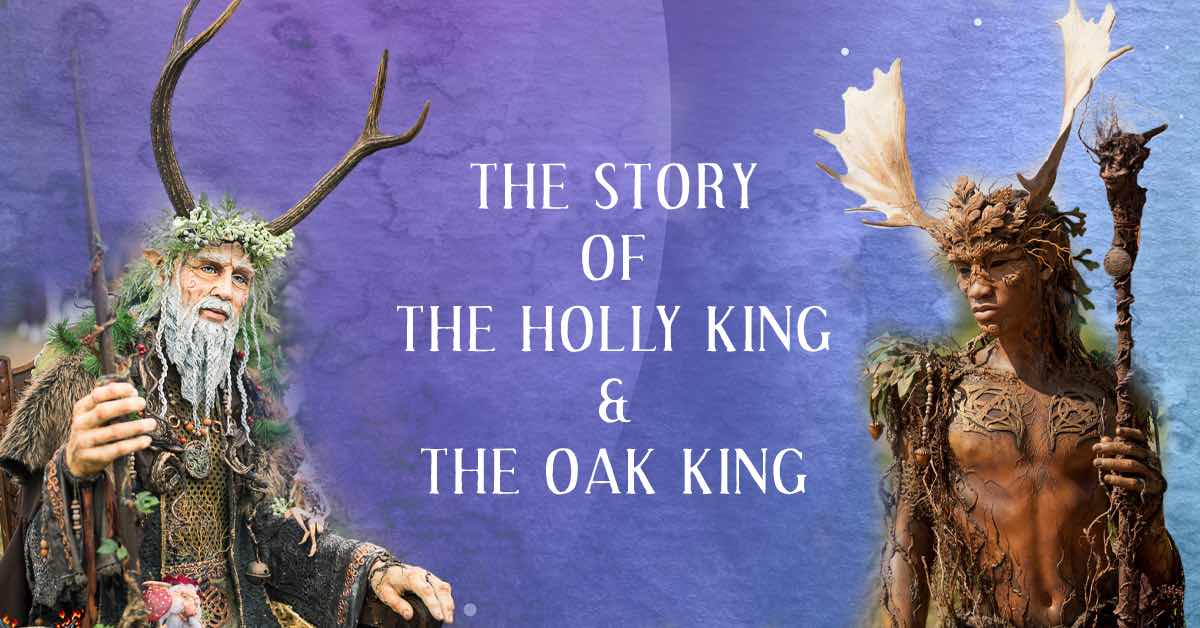THE HOLLY KING
From the Celtic tradition, we get a pair of ancient pagan images who fight for supremacy at Yule.
The Holly King and the Oak King were most likely an idea containing various conceptual elements of the Druids to whom these two trees were highly sacred. The Oak King (king of the waxing year) kills the Holly King (king of the waning year) at Yule.
The Oak King then reigns until Midsummer when the two battle again, this time with the Holly King as the victor.

The Holly King, who has evolved into the present day Santa Claus, wears red, dons a sprig of holly in his hat, and drives a team of eight (total number of solar sabbats) deer, an animal sacred to the Celtic Gods.
Holly and mistletoe are traditional to the season through commemoration of the battle.
The holly was hung in honor of the Holly King; the mistletoe (which grows high in the branches of oak trees) in honor of the Oak King.
The Oak King and Holly King are mortal enemies at Midsummer and Yule, but they are two sides of a whole, and neither could exist without the other.
SANTA CLAUS
Today's Santa is a folk figure with multicultural roots. He embodies characteristics of Saturn (Roman agricultural god), Cronos (Greek god, also known as Father Time), the Holly King (Celtic god of the dying year), Father Ice/Grandfather Frost (Russian winter god), Odin/Wotan (Scandinavian/Teutonic All-Father who rides the sky on an eight-legged horse), Frey (Norse fertility god), the Tomte (a Norse Land Spirit known for giving gifts to children at this time of year), and Thor (Norse sky god who rides the sky in a chariot drawn by goats).
Julbock or Julbukk, the Yule goat, from Sweden and Norway, had his beginnings as carrier for the god Thor. Now he carries the Yule elf when he makes his rounds to deliver presents and receive his offering of porridge.
When Early Christians co-opted the Yule holiday, they replaced the ancient Holly King with religious figures like St. Nicholas, who was said to live in Myra (Turkey) in about 300 A.D. Born an only child of a wealthy family, he was orphaned at an early age when both parents died of the plague.
He grew up in a monastery and at the age of 17 became one of the youngest priests ever.
Many stories are told of his generosity as he gave his wealth away in the form of gifts to those in need, especially children.
Legends tell of him either dropping bags of gold down chimneys or throwing the bags through the windows where they landed in the stockings hung from the fireplace to dry.
Some years later Nicholas became a bishop--hence the bishop's hat or miter, long flowing gown, white beard and red cape.
When the Reformation took place, the new Protestants no longer desired St. Nicholas as their gift-giver as he was too closely tied to the Catholic Church.
Therefore, each country or region developed their own gift-giver.
In France he was known as Pare Noel. In England he was Father Christmas (always depicted with sprigs of holly, ivy, or mistletoe).
Germany knew him as Weihnachtsmann (Christmas man).
When the communists took over in Russia and outlawed Christianity, the Russians began to call him Grandfather Frost, who wore blue instead of the traditional red.
To the Dutch, he was Sinterklaas (which eventually was mispronounced in America and became Santa Claus).
La Befana, a kindly witch, rides a broomstick down the chimney to deliver toys into the stockings of Italian children.
We are sure you have noticed that all these Santas closely resemble the earliest beginnings as god of the year ending.
